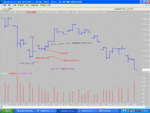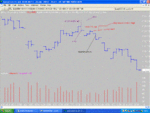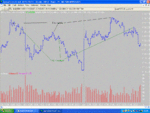china white
Established member
- Messages
- 979
- Likes
- 12
Thursday 3rd of June
Do u know what today's action was? A replay of the war btwn germans and russians in WWII 😆 I will have to be calling germans the bulls and russians the bears - pls no comment on that! :cheesy:
let us try to analyse it.
A - miniscule tick size drops in price r met with volume spikes. Not incredibly high levels of volume - but remember AT THAT TIME there was no way to see what the closing volume levels wud be. Clear spikes meaning short covering on tick size advance of the sellers. What is to follow? The invasion of the bulls (germans) into russia (bears).
B - parabolic explosion of volume with a significan move in price (June 1941 😆 ) 4 points in 8 minutes. Not the speed of the Superman but a steady advance of bulls up to Smolensk (August 1941).
C - 10:34 and 10:36 bars - look how at the peak of the offensive (buying volume) germans have to stop to pull up supplies and russians manage to close 10:36 bar lower than10:34 bar on sharply lower volume. The battle of Smolensk unfolds where russians regain surprisingly much. One problem for Stalin tho 😆 - he again starts getting nasty volume spikes on miniscule tick size advances (german tanks fully reloaded and refuelled and cover shorts). And since russians themselves have not got too much to bring it down, we get a cup sort of bottom with a logical development:
D - 2 battles of Moscow. NOW VERY IMPORTANT THING - LONGS FROM YESTERDAY (aka 6 Siberian divisions arriving to Moscow by 11:08 new york time 😆 ). Why r they so important? they want to close flat, this gap closure is their golden chance to do so. LOOK AT 11:38 bar - on a stellar volume of 7,000 futures in 2 min exchanging hands what does ES do? goes up 1 point on that bar and recoils 0.5 pts straight back. LONGS R JUMPING OUT! "Panzer SS" is not yet defeated but firmly stopped by the Siberians :cheesy:
E and F - the battle of Stalingrad (1942-43). Look at E - yes the bulls got further into the russian territory, but another point up is happily picked up by remaining longs to unwind their positions. They even do so in the middle of lunchtime! E volume may not seem to significant, but let us run some math here. In the 2nd offensive on Moscow (last part of line D) 19,000 futs exchanged hands over 10 minutes, on E (in the middle of lunch time!!!) 13,500 futs were exchanged over 8 minutes. This is not a joke - this is germans getting really grilled on the streets of Stalingrad! 😆 Remaining longs r selling their positions, they do not have enough bids in the middle of lunchtime, they know that, they work clips, small fish is rushing in thinking they r buying into another leg up, they r atually buying the bottom! Voila - quite high volume levels for any lunchtime. Not clear yet whats gonna happen next? Look at F - Hitler sends 4 Panzer divisions from the Caucasus to break Stalingrad blockade - u get volume spikes on their microscopic advances - the russians r selling every uptick!
G - the loss of 1123 - which acted as strong support and clear 1123 sup/res resolution - was perhaps THE MOST IMPORTANT single event of the day. Russians r clearly staging a full scale offensive - on increasing volume. H&S target met. Now what? The war is not over yet.
H - what the russians call the battle of Kursk arch and the germans call Panzer battle at Prokhorovka. What's important about that? Look at H - very decent steady volume (by then volume yardstick of the day) - loads of fighting with bulls taking 40-50 minutes to regain the territory they lost in 6 minutes previously! The culmination is selling volume spike I - the proper battle at Prokhorovka.
I - important thing here - compare D-E and G-I. Seemingly similar aren't they, in reverse of course? I is only marginally lower than culmination of G, just like E is only marginally higher than culmination of D. SO WHY E IS LONG CLOSING WHILE I IS GENUINE SHORTS? Just look at price-volume dynamics btwn D-E and G-I, especially keeping in mind that heavy fighting along line H.
J and K - u may still have doubts, but a feeble german counter-offensive (J) on decreasing volume explodes into a parabolic genuine shorting on K. Shorts do not have enough bids, that is why price travels so far south. Russians smash every single german along a great distance from Kursk to Berlin (top of line K) on the top selling volume of the day.
L - do u think that spike in volume is short covering? No it is final battle of Berlin. It is shorts, russian bears all over, it is just there is no more room to travel (end of day - AngloAmericans on the River Elb :cheesy: )
Do u know what today's action was? A replay of the war btwn germans and russians in WWII 😆 I will have to be calling germans the bulls and russians the bears - pls no comment on that! :cheesy:
let us try to analyse it.
A - miniscule tick size drops in price r met with volume spikes. Not incredibly high levels of volume - but remember AT THAT TIME there was no way to see what the closing volume levels wud be. Clear spikes meaning short covering on tick size advance of the sellers. What is to follow? The invasion of the bulls (germans) into russia (bears).
B - parabolic explosion of volume with a significan move in price (June 1941 😆 ) 4 points in 8 minutes. Not the speed of the Superman but a steady advance of bulls up to Smolensk (August 1941).
C - 10:34 and 10:36 bars - look how at the peak of the offensive (buying volume) germans have to stop to pull up supplies and russians manage to close 10:36 bar lower than10:34 bar on sharply lower volume. The battle of Smolensk unfolds where russians regain surprisingly much. One problem for Stalin tho 😆 - he again starts getting nasty volume spikes on miniscule tick size advances (german tanks fully reloaded and refuelled and cover shorts). And since russians themselves have not got too much to bring it down, we get a cup sort of bottom with a logical development:
D - 2 battles of Moscow. NOW VERY IMPORTANT THING - LONGS FROM YESTERDAY (aka 6 Siberian divisions arriving to Moscow by 11:08 new york time 😆 ). Why r they so important? they want to close flat, this gap closure is their golden chance to do so. LOOK AT 11:38 bar - on a stellar volume of 7,000 futures in 2 min exchanging hands what does ES do? goes up 1 point on that bar and recoils 0.5 pts straight back. LONGS R JUMPING OUT! "Panzer SS" is not yet defeated but firmly stopped by the Siberians :cheesy:
E and F - the battle of Stalingrad (1942-43). Look at E - yes the bulls got further into the russian territory, but another point up is happily picked up by remaining longs to unwind their positions. They even do so in the middle of lunchtime! E volume may not seem to significant, but let us run some math here. In the 2nd offensive on Moscow (last part of line D) 19,000 futs exchanged hands over 10 minutes, on E (in the middle of lunch time!!!) 13,500 futs were exchanged over 8 minutes. This is not a joke - this is germans getting really grilled on the streets of Stalingrad! 😆 Remaining longs r selling their positions, they do not have enough bids in the middle of lunchtime, they know that, they work clips, small fish is rushing in thinking they r buying into another leg up, they r atually buying the bottom! Voila - quite high volume levels for any lunchtime. Not clear yet whats gonna happen next? Look at F - Hitler sends 4 Panzer divisions from the Caucasus to break Stalingrad blockade - u get volume spikes on their microscopic advances - the russians r selling every uptick!
G - the loss of 1123 - which acted as strong support and clear 1123 sup/res resolution - was perhaps THE MOST IMPORTANT single event of the day. Russians r clearly staging a full scale offensive - on increasing volume. H&S target met. Now what? The war is not over yet.
H - what the russians call the battle of Kursk arch and the germans call Panzer battle at Prokhorovka. What's important about that? Look at H - very decent steady volume (by then volume yardstick of the day) - loads of fighting with bulls taking 40-50 minutes to regain the territory they lost in 6 minutes previously! The culmination is selling volume spike I - the proper battle at Prokhorovka.
I - important thing here - compare D-E and G-I. Seemingly similar aren't they, in reverse of course? I is only marginally lower than culmination of G, just like E is only marginally higher than culmination of D. SO WHY E IS LONG CLOSING WHILE I IS GENUINE SHORTS? Just look at price-volume dynamics btwn D-E and G-I, especially keeping in mind that heavy fighting along line H.
J and K - u may still have doubts, but a feeble german counter-offensive (J) on decreasing volume explodes into a parabolic genuine shorting on K. Shorts do not have enough bids, that is why price travels so far south. Russians smash every single german along a great distance from Kursk to Berlin (top of line K) on the top selling volume of the day.
L - do u think that spike in volume is short covering? No it is final battle of Berlin. It is shorts, russian bears all over, it is just there is no more room to travel (end of day - AngloAmericans on the River Elb :cheesy: )









